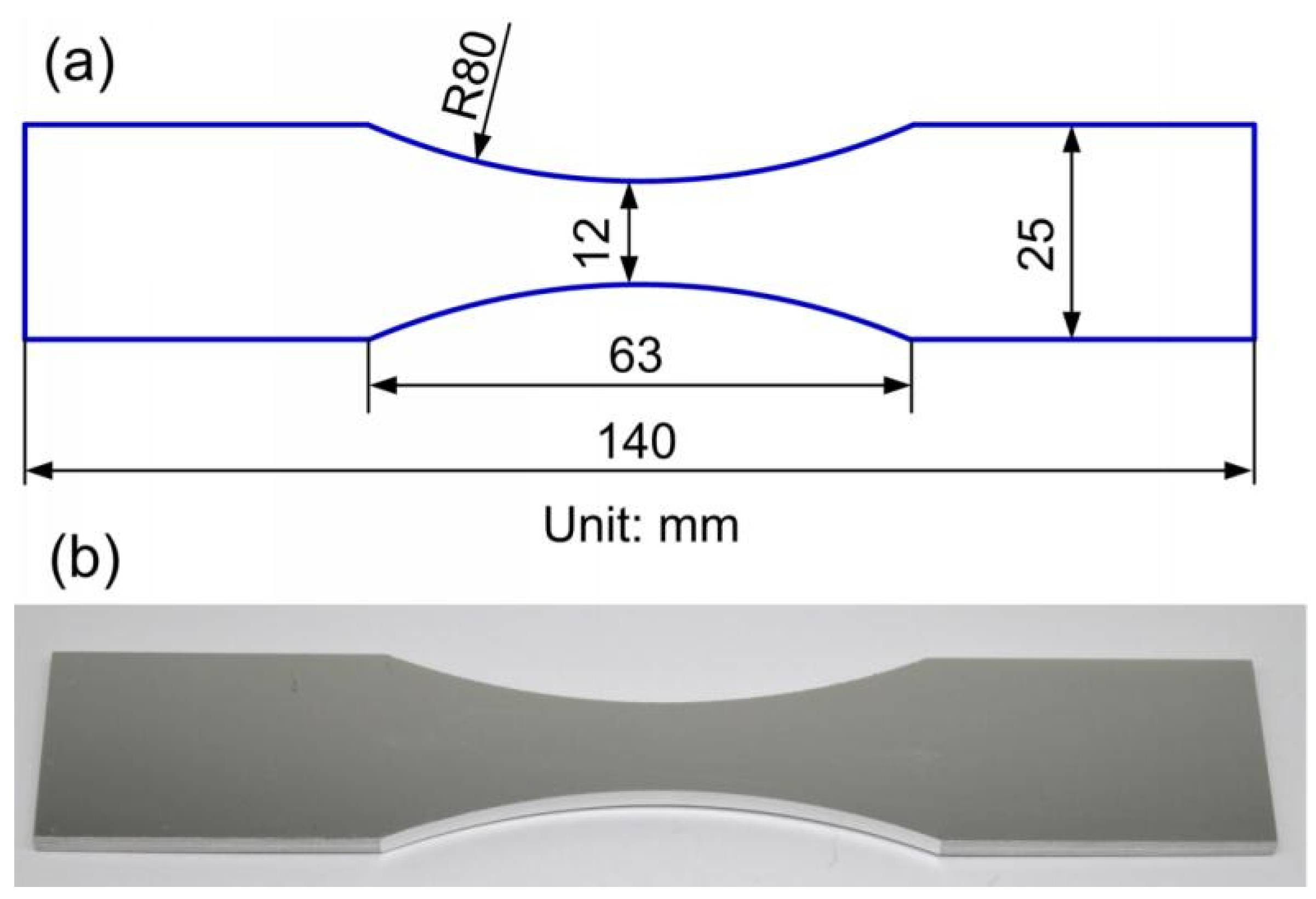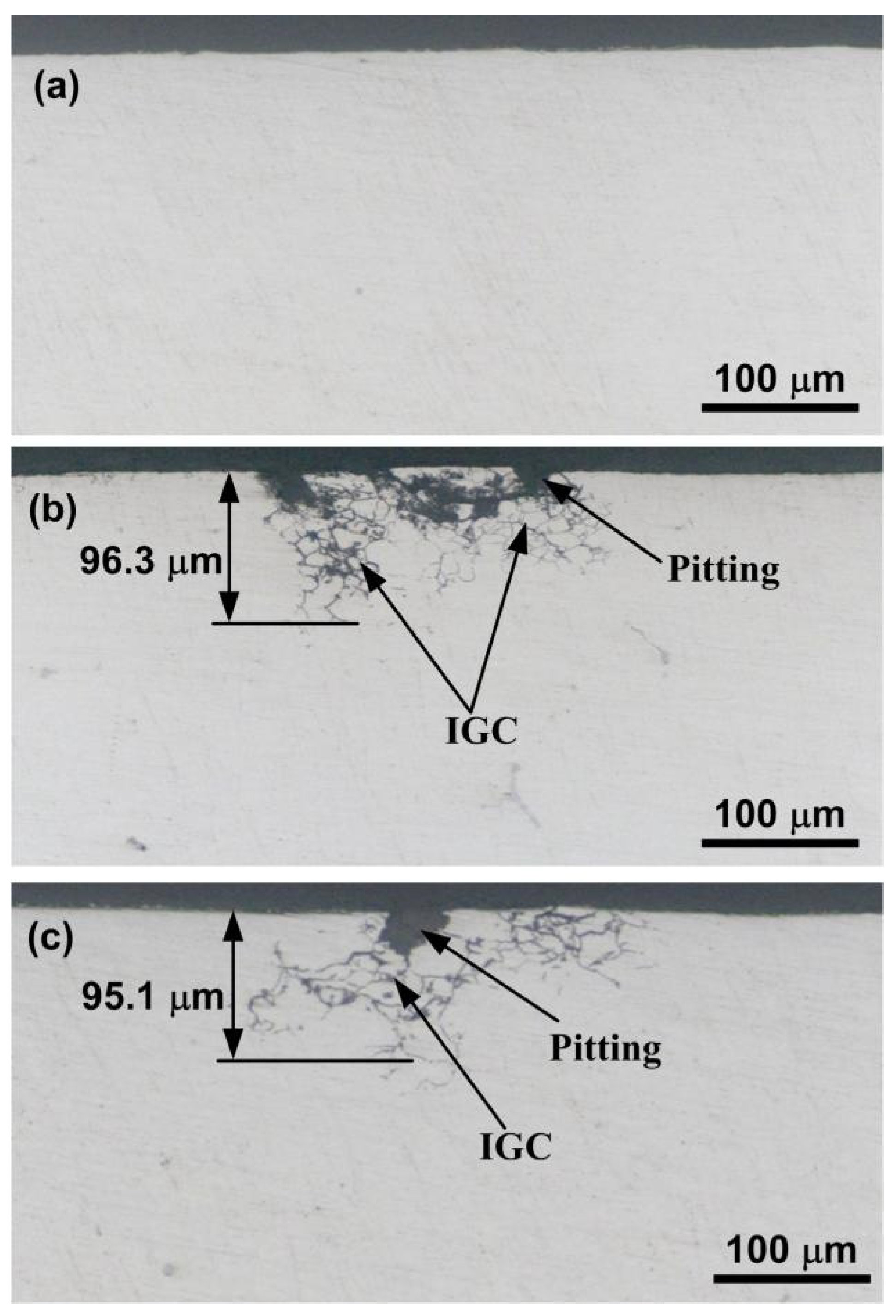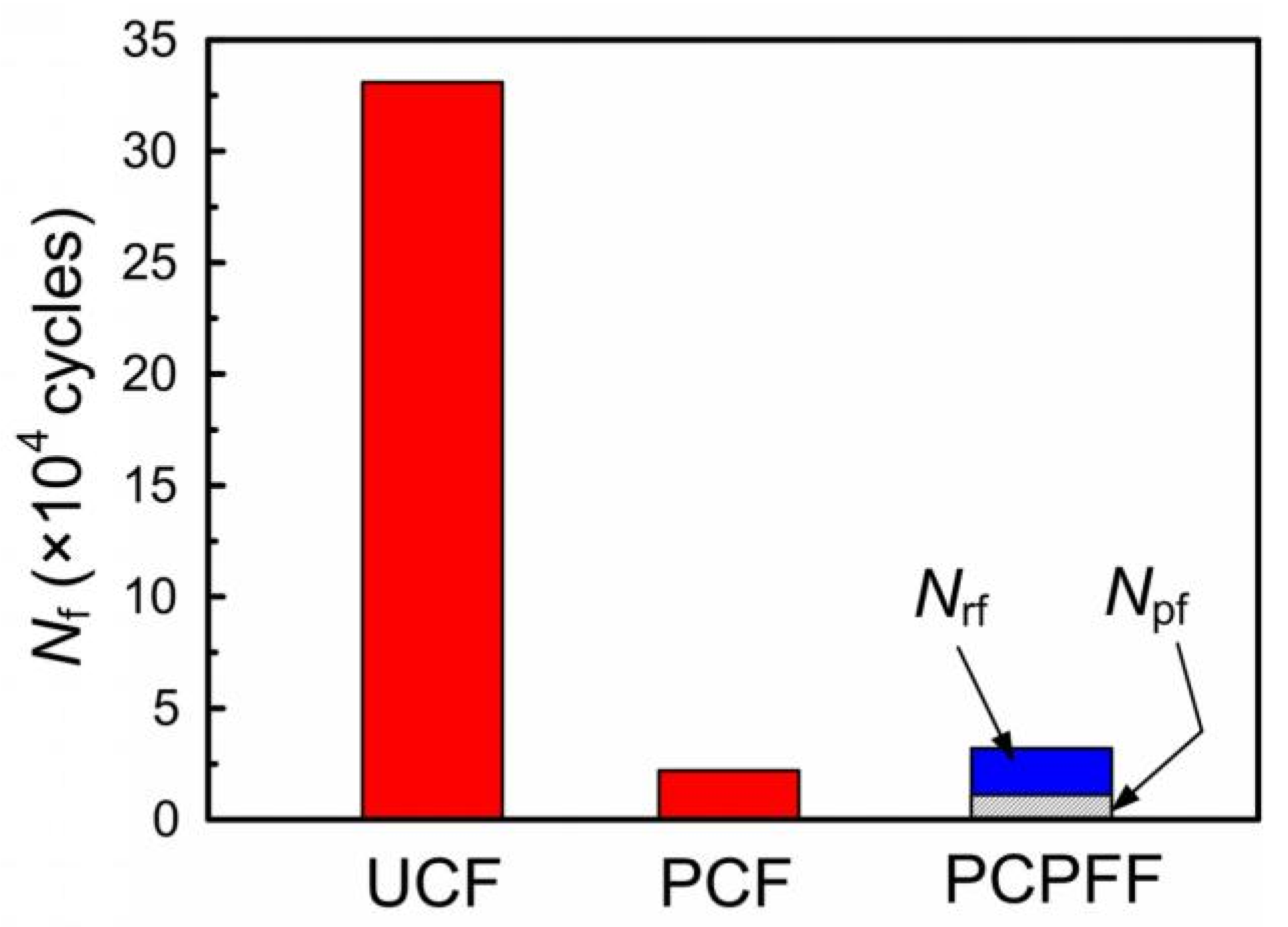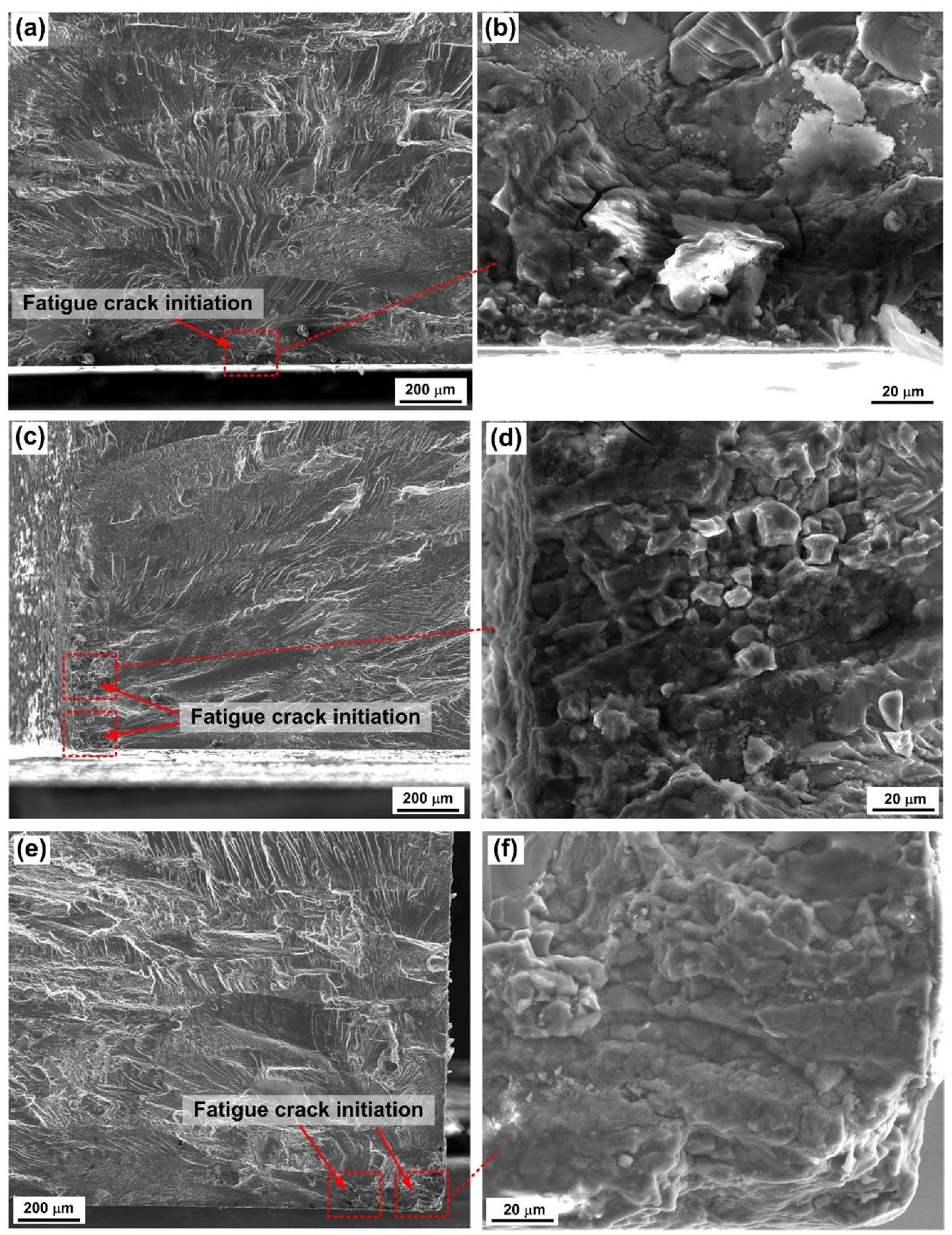Effects of Actual Marine Atmospheric Pre-Corrosion and Pre-Fatigue on the Fatigue Property of 7085 Aluminum Alloy
Abstract
1. Introduction
2. Experimental Procedure
3. Results and Discussion
3.1. Corrosion Characteristics
3.2. Fatigue Property
4. Conclusions
- (1)
- For the 7085-T7452 aluminum alloy exposed for three months in an actual marine atmosphere, both pitting corrosion and IGC were observed. The dominant corrosion mode, IGC, was attributed to the preferential anodic dissolution of GBPs (η) which had a lower corrosion potential than that of the aluminum alloy matrix.
- (2)
- Local stress concentration caused by the nonuniform depth of IGC could seriously reduce the initiation period of fatigue crack under cyclic stresses and thus dramatically decreased the fatigue life of the 7085-T7452 aluminum alloy.
- (3)
- Selective prefatigue could improve the fatigue life of the precorroded 7085 aluminum alloy, which might be related to the increase of the dislocation density and the release of residual stresses due to the intermittent effect following the prefatigue.
Author Contributions
Funding
Institutional Review Board Statement
Informed Consent Statement
Data Availability Statement
Conflicts of Interest
References
- Zhou, B.; Liu, B.; Zhang, S.G. The advancement of 7xxx series aluminum alloys for aircraft structures: A review. Metals 2021, 11, 718. [Google Scholar] [CrossRef]
- Wang, Y.; Cao, L.; Wu, X.; Tong, X.; Liao, B.; Huang, G.; Wang, Z. Effect of retrogression treatments on microstructure, hardness and corrosion behaviors of aluminum alloy 7085. J. Alloys Compd. 2020, 814, 152264. [Google Scholar] [CrossRef]
- Xu, W.F.; Wu, X.K.; Ma, J.; Lu, H.J.; Luo, Y.X. Abnormal fracture of 7085 high strength aluminum alloy thick plate joint via friction stir welding. J. Mater. Res. Technol. 2019, 8, 6029–6040. [Google Scholar] [CrossRef]
- Liu, S.; Li, Q.; Lin, H.; Sun, L.; Long, T.; Ye, L.; Deng, Y. Effect of quench-induced precipitation on microstructure and mechanical properties of 7085 aluminium alloy. Mater. Des. 2017, 132, 119–128. [Google Scholar] [CrossRef]
- Chen, S.Y.; Chen, K.H.; Dong, P.X.; Ye, S.P.; Huang, L.P. Effect of heat treatment on stress corrosion cracking, fracture toughness and strength of 7085 aluminum alloy. Trans. Nonferrous Met. Soc. China 2014, 24, 2320–2325. [Google Scholar] [CrossRef]
- Chen, S.Y.; Chen, K.H.; Peng, G.S.; Xin, L.; Chen, X.H. Effect of quenching rate on microstructure and stress corrosion cracking of 7085 aluminum alloy. Trans. Nonferrous Met. Soc. China 2012, 22, 47–52. [Google Scholar] [CrossRef]
- Li, C.; Wang, S.; Zhang, D.; Liu, S.; Shan, Z.; Zhang, X. Effect of Zener-Hollomon parameter on quench sensitivity of 7085 aluminum alloy. J. Alloys Compd. 2016, 688, 456–462. [Google Scholar] [CrossRef]
- Karabin, M.E.; Barlat, F.; Shuey, R.T. Finite element modeling of plane strain toughness for 7085 aluminum alloy. Metall. Mater. Trans. A 2009, 40, 354–364. [Google Scholar] [CrossRef][Green Version]
- Menzemer, C.C.; Lam, D.F.; Srivatsan, T.S. An investigation of strain concentration in high-strength Al-Zn-Mg-Cu Alloy 7085 subjected to tensile deformation. J. Mater. Eng. Perform. 2010, 19, 705–713. [Google Scholar] [CrossRef]
- Dursun, T.; Soutis, C. Recent developments in advanced aircraft aluminium alloys. Mater. Des. 2014, 56, 862–871. [Google Scholar] [CrossRef]
- Prabhu, T. Ram. An overview of high-performance aircraft structural Al alloy-AA7085. Acta Metall. Sin. (Engl. Lett.) 2015, 28, 909–921. [Google Scholar] [CrossRef]
- Burns, J.T.; Boselli, J. Effect of plate thickness on the environmental fatigue crack growth behavior of AA7085-T7451. Int. J. Fatigue 2016, 83, 253–268. [Google Scholar] [CrossRef]
- Maity, R.; Singh, A.; Paul, S.K. Investigations of fatigue and fracture behavior of AA 7085. J. Mater. Eng. Perform. 2021, 30, 7247–7258. [Google Scholar] [CrossRef]
- Dai, P.; Luo, X.; Yang, Y.; Kou, Z.; Huang, B.; Zang, J.; Ru, J. The fracture behavior of 7085-T74 Al alloy ultra-thick plate during high cycle fatigue. Metall. Mater. Trans. A 2020, 51, 3248–3255. [Google Scholar] [CrossRef]
- Shuey, R.T.; Barlat, F.; Karabin, M.E.; Chakrabarti, D.J. Experimental and analytical investigations on plane strain toughness for 7085 aluminum alloy. Metall. Mater. Trans. A 2009, 40, 365–376. [Google Scholar] [CrossRef][Green Version]
- Luong, H.; Hill, M.R. The effects of laser peening on high-cycle fatigue in 7085-T7651 aluminum alloy. Mater. Sci. Eng. A 2008, 477, 208–216. [Google Scholar] [CrossRef]
- Chen, Y.J.; Liu, C.C.; Zhou, J.; Wang, F.S. Effect of alternate corrosion factors on multiaxial low-cycle fatigue life of 2024-T4 aluminum alloy. J. Alloys Comp. 2019, 772, 1–14. [Google Scholar] [CrossRef]
- Song, H.P.; Liu, C.C.; Zhang, H.; Yang, X.D.; Chen, Y.J.; Leen, S.B. Experimental investigation on damage evolution in pre-corroded aluminum alloy 7075-T7651 under fatigue loading. Mater. Sci. Eng. A 2020, 799, 140206. [Google Scholar] [CrossRef]
- Joshi, G.; Mall, S. Crack Initiation and growth from pre-corroded pits in aluminum 7075-T6 under laboratory air and salt water environments. J. Mater. Eng. Perform. 2017, 26, 2293–2304. [Google Scholar] [CrossRef]
- Genel, K. The effect of pitting on the bending fatigue performance of high-strength aluminum alloy. Scr. Mater. 2007, 57, 297–300. [Google Scholar] [CrossRef]
- Chen, Y.J.; Liu, C.C.; Zhou, J.; Wang, X.C. Multiaxial fatigue behaviors of 2024-T4 aluminum alloy under different corrosion conditions. Int. J. Fatigue 2017, 98, 269–278. [Google Scholar] [CrossRef]
- Walde, K.V.D.; Hillberry, B.M. Multiple fatigue crack growth in pre-corroded 2024-T3 aluminum. Int. J. Fatigue 2007, 29, 1269–1281. [Google Scholar]
- Co, N.E.C.; Burns, J.T. Effects of macro-scale corrosion damage feature on fatigue crack initiation and fatigue behavior. Int. J. Fatigue 2017, 103, 234–247. [Google Scholar] [CrossRef]
- Zhang, S.; Zhang, T.; He, Y.T.; Du, X.; Ma, B.L.; Zhang, T.Y. Long-term atmospheric pre-corrosion fatigue properties of epoxy primer-coated 7075-T6 aluminum alloy structures. Int. J. Fatigue 2019, 129, 105225. [Google Scholar] [CrossRef]
- Zhang, Y.; Pelliccia, D.; Milkereit, B.; Kirby, N.; Starink, M.J.; Rometsch, P.A. Analysis of age hardening precipitates of Al-Zn-Mg-Cu alloys in a wide range of quenching rates using small angle X-ray scattering. Mater. Des. 2018, 142, 259–267. [Google Scholar] [CrossRef]
- Li, M.H.; Yang, Y.Q.; Feng, Z.Q.; Huang, B.; Luo, X.; Lou, J.H.; Ru, J.G. Precipitation sequence of η phase along low-angle grain boundaries in Al-Zn-Mg-Cu alloy during artificial aging. Trans. Nonferrous Met. Soc. China 2014, 24, 2061–2066. [Google Scholar] [CrossRef]
- Azarniya, A.; Taheri, A.K.; Taheri, K.K. Recent advances in ageing of 7xxx series aluminum alloys: A physical metallurgy perspective. J. Alloys Compd. 2019, 781, 945–983. [Google Scholar] [CrossRef]
- Kairy, S.K.; Turk, S.; Birbilis, N.; Shekhter, A. The role of microstructure and microchemistry on intergranular corrosion of aluminium alloy AA7085-T7452. Corros. Sci. 2018, 143, 414–427. [Google Scholar] [CrossRef]
- Yang, X.B.; Liu, J.Z.; Chen, J.H.; Wan, C.Y.; Fang, L.; Liu, P.; Wu, C.L. Relationship between the strengthening effect and the morphology of precipitates in Al-7.4Zn-1.7Mg-2.0Cu alloy. Acta Metall. Sin. (Engl. Lett.) 2014, 27, 1070–1077. [Google Scholar] [CrossRef]
- Yang, W.C.; Ji, S.X.; Zhang, Q.; Wang, M.P. Investigation of mechanical and corrosion properties of an Al-Zn-Mg-Cu alloy under various ageing conditions and interface analysis of η′ precipitate. Mater. Des. 2015, 85, 752–761. [Google Scholar] [CrossRef]
- Wang, Z. Handbook of Aluminum Alloy and Its Working; Central South University Press: Changsha, China, 2000. [Google Scholar]
- Dai, S.G. Environmental Chemistry; Higher Education Press: Beijing, China, 2006. [Google Scholar]






| Element | Zn | Mg | Cu | Fe | Ti | Si | Cr | Mn | Al |
|---|---|---|---|---|---|---|---|---|---|
| Composition (wt %) | 7.02 | 1.35 | 1.54 | 0.054 | 0.024 | <0.05 | <0.02 | <0.02 | Bal. |
Publisher’s Note: MDPI stays neutral with regard to jurisdictional claims in published maps and institutional affiliations. |
© 2022 by the authors. Licensee MDPI, Basel, Switzerland. This article is an open access article distributed under the terms and conditions of the Creative Commons Attribution (CC BY) license (https://creativecommons.org/licenses/by/4.0/).
Share and Cite
Shi, L.; Xiang, L.; Tao, J.; Liu, J.; Chen, Q.; Zhong, Y. Effects of Actual Marine Atmospheric Pre-Corrosion and Pre-Fatigue on the Fatigue Property of 7085 Aluminum Alloy. Metals 2022, 12, 81. https://doi.org/10.3390/met12010081
Shi L, Xiang L, Tao J, Liu J, Chen Q, Zhong Y. Effects of Actual Marine Atmospheric Pre-Corrosion and Pre-Fatigue on the Fatigue Property of 7085 Aluminum Alloy. Metals. 2022; 12(1):81. https://doi.org/10.3390/met12010081
Chicago/Turabian StyleShi, Laixin, Lin Xiang, Jianquan Tao, Jun Liu, Qiang Chen, and Yong Zhong. 2022. "Effects of Actual Marine Atmospheric Pre-Corrosion and Pre-Fatigue on the Fatigue Property of 7085 Aluminum Alloy" Metals 12, no. 1: 81. https://doi.org/10.3390/met12010081
APA StyleShi, L., Xiang, L., Tao, J., Liu, J., Chen, Q., & Zhong, Y. (2022). Effects of Actual Marine Atmospheric Pre-Corrosion and Pre-Fatigue on the Fatigue Property of 7085 Aluminum Alloy. Metals, 12(1), 81. https://doi.org/10.3390/met12010081





